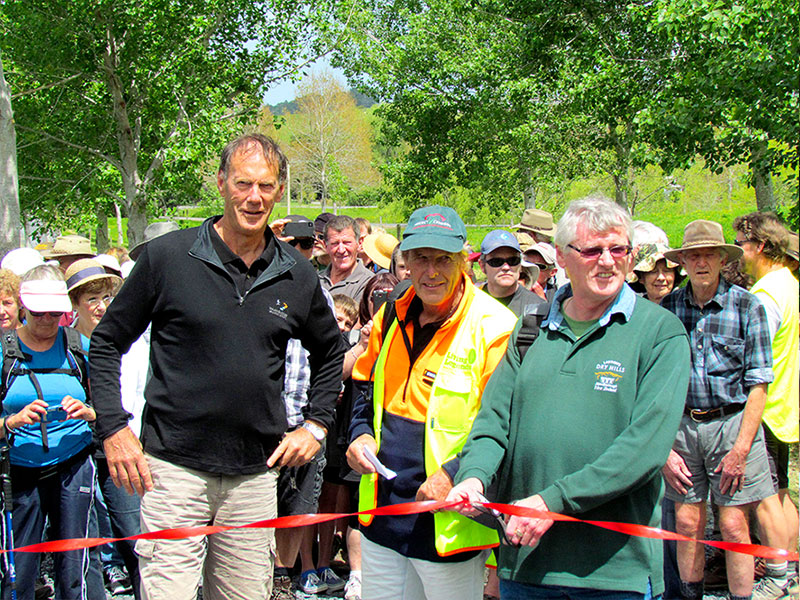Gordon Hosking: change maker
7 min read
Dr Gordon Hosking (centre) at the 2012 Mangawhai Track opening. Photo: supplied
The Tanekaha Tracks is one of the most popular New Zealand tracks for the walking fraternity. On the southern slopes of the Brynderwyn Hills, it’s just 10 minutes from Mangawhai, and in the last 12 months, it’s seen more than 6000 visitors. That’s quite some foot traffic.
The 14km well-formed walking track is set in beautiful native bush with giant puriri, tanekaha stands, and mature kanuka along with more than 140 other native species recorded in the reserve.
But access to this jewel in our backyard was limited by a deeply incised stream at the block’s base, until, thanks to the efforts of Northland conservationist Dr Gordon Hosking and Walking Access New Zealand, a swing bridge was constructed to access what’s now one of the premier walking destinations in the North Island.
“We were lucky enough to have a beautiful 300-hectare DOC reserve right on our doorstep on the southern slopes of the Brynderwyns,” says Hosking, “and with DOC agreement, we proposed a short walk to a waterfall that was rumoured to exist within the reserve.
“Unfortunately, access was limited, and it was Walking Access New Zealand that came to the rescue, funding the little swing bridge that is now the delightful entry to the track complex. After finding the waterfall and building the track, it was onward and upward, extending the walk to the Brynderwyn ridge and eventually forming a loop back to the bridge.”
The improved access resulting from Tanehaka Tracks network also enabled predator trapping with DOC to successfully reintroduce a kiwi population on the adjoining Marunui Conservation land.
This is just one success story. Hosking and his team of 70 volunteers in the Mangawhai Tracks Charitable Trust have helped open and develop new tracks across the area – a feat that led him to a nomination at this year’s Outdoor Access Champion Award, which he now shares with Shaun Norman.
“I am really getting it for the work of the whole team: the up to 15 ‘Trackies’ who turn up every Friday morning with spades, hand saws, and loppers and get stuck in building and maintaining tracks,” Gordon says.
“I do a bit of organisation and try to line up future projects; a complete waste of time without the enthusiasm and feet on the ground of our team. This award recognises the efforts of the Tracks Trust and its Trackies in developing some outstanding walking opportunities for its Mangawhai community and wider New Zealand.”
Initial interest
Hosking’s interest in the outdoors developed early on when he and his brothers would head off up Hackthorn Rd with lunch and water bottles for a day wandering the Port Hills, dawn until dusk.
“Our parents had no qualms for our safety, and we would not be back for tea,” says. “This was the 1950s!”
Hosking was one of six kids (four boys and two girls) and his parents, he says, encouraged them “using a loose but watchful rein”.
He adds that although his parents were quite sporty in their youth (“Mum was an accomplished tennis player and Dad played rugby”), neither were into the great outdoors. But the family often headed to their bach at Waikuku Beach and once they were old enough, camping was the holiday pastime.
“Lake Tekapo, Porters Pass, Lake Wanaka, Lake Rotoiti (SI) were favourites, and we spent much of our time above the bush line on the St Anaud Range. We never appreciated the work our parents put into getting away camping with six kids, but it sold me on the mountains, and I spent much of my 20s in the Southern Alps. I ended up teaching for the year of 1967 at Karamea District High along with one of my younger brothers – hunting and fishing whenever we were not in a classroom.”
Growing up, Hosking continued to explore the outdoors. In 2016, at the age of 73, he rode the Old Ghost Road.
“I was to do it with three mates but for various reasons they pulled out at the last minute, so I did it over two days with a night at Ghost Lake hut. What a magnificent experience! Both as a keen mountain biker and as a lover of our high-altitude forests and shrublands, it was pure joy, but I was knackered when I hit the West Coast. My very indulgent wife of over 50 years is always there to collect me at the end.”
Hosking has been a keen mountain biker for more than 40 years – not surprising since he worked for 30 years at the Forest Research Institute in Rotorua, which borders on Whaka Forest and its fabulous mountain bike trails.
“As a member of the local club, I adopted a downhill track, which I maintained and improved over a number of years,” he says.
While he still gets out on his bike four or five times a week, it’s a bit more sedate territory now than in his younger years.
“My wife and I have also been keen sailors, initially in trailer yachts and later keelers, mainly in our coastal waters and lakes.
“My professional life as a forest entomologist has taken me to most corners of the country and much of my time is spent in our native forests.”
Project Crimson: saving pōhutukawa

Having spent so much time in the bushes, exploring the magnificence our country has to offer, it seems only natural that Hosking was drawn towards it.
Which brings us to his next project – one among many – that saved the beloved Kiwi Christmas tree from near extinction.
Project Crimson was formed in 1989 following Hosking’s research into the decline of pōhutukawa that showed only 10% of the pre-European tree population remained and much of it in poor condition due to possum damage and land clearing.
A partnership between DOC and NZ Forest Products was formed with the aim to restore and protect pōhutukawa throughout its natural range.
Hosking was a foundation trustee and remained one for more than 25 years.
During these years, Trees that Count – the brainchild of Sir Stephen Tindall – approached Project Crimson to manage an initiative to restore New Zealand’s native forest cover through extensive planting on both private and public land. Hosking was a member of the planning team that got the initiative off the ground.
Hosking was also part of Living Legends – the Tindall Foundation-sponsored project undertaken by Project Crimson to plant 10,000 native plants on public land at 17 sites throughout the country as a lasting memorial to the 2011 Rugby World Cup.
“I was the operations manager for the project, which involved finding the sites, organising the volunteers, sourcing the plants, and ensuring post-planting care,” he says.
The three-year project resulted in 170,035 plants in the ground from the efforts of 8320 volunteers.
“Of all the planting days I’ve been involved in through Project Crimson, the most memorable was that undertaken by a small iwi group whose marae was at the end of a long gravel road on the coast north of Ruatoria on the East Coast – hard to find a more remote spot.
“Virtually every member of the tiny community of Reporua, from aunties to toddlers, joined in planting an eroding coastal paddock with several hundred pōhutukawa. It was a joyous event, filled with laughter and fun and wonderful kai.”
Hosking’s current project is to build a 500-metre boardwalk providing an important part of Mangawhai’s vision of a ‘round the harbour walkway’.
“We have raised the $100,000 for materials and completed half the distance before having to cease for the banded rail breeding season and will complete the project next winter.
“The Trackies provide all the labour with the challenge of working around tides, driving piles in sticky mud, and removing mangroves from its path.
“The 1.5-metre wide structure will be wheelchair accessible, will have three passing bays with seats, and is being engineered to a high standard with all stainless-steel fixings. It’s is already a tourist attraction.”
Community engagement

Hosking says he never misses an opportunity to speak with community groups, Council, and other organisations,
“Our wider vision is focused on extending the outdoor recreational facilities for our community.
“The Trackies are an active component of the annual Mangawhai Walking Weekend acting as guides for more than 30 individual walks.
“As a member of the organising committee for the past five years, I’ve coordinated the Trackie contribution, upgrading tracks where necessary and organising labour to run the event, which attracts more than 500 walkers.
“I am also active in lobbying Council for recreational initiatives and after a seven-year effort, have finally convinced them to designate a 120-hectare bush block on their wastewater disposal farm for recreation, including walking tracks and a mountain bike park.”
In the face of intensive development, Hosking says his main concern is the increasing difficulty in gaining access to New Zealand’s coastal environment.
Owners of expensive properties resent the public use of esplanade reserves, which are often in their view. This leads to the expensive resource consent process that few voluntary organisations can afford.
“The 500-metre coastal boardwalk that we’re building to provide a through walkway currently has no exit.
“The resource consent we required went all the way to the Environment Court and cost us $20,000 before the first pile could be put down.”
But the cost (both literally and figuratively) of being a part of such projects doesn’t fizzle out his passion for the outdoors.
“Quite simply, the people I get to work with are my motivation: dedicated, selfless, and invariably interesting. What more could you ask?
“The great outdoors is New Zealand’s greatest asset, and it is mostly free.
“Volunteering in it is a whole added experience. Do it now! Life is short.”
Outdoor Access Champion awards
The Outdoor Access Champion awards are an annual event organised by the New Zealand Walking Access Commission Ara Hīkoi Aotearoa.
The awards celebrate people and community groups around the country who are developing trails and making it easier for people to experience the outdoors.
Nominations are now open (until 31 January 2021) for 2021 outdoor access champions.





